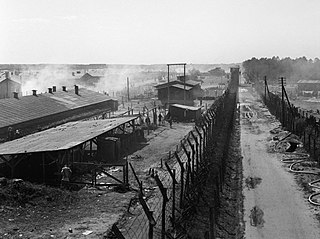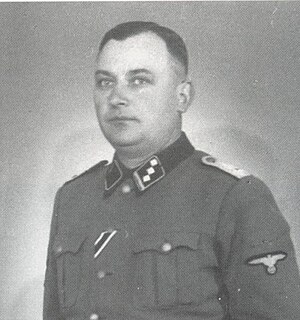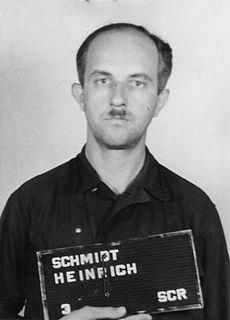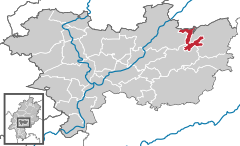
The Schutzstaffel was a major paramilitary organization under Adolf Hitler and the Nazi Party (NSDAP) in Nazi Germany, and later throughout German-occupied Europe during World War II. It began with a small guard unit known as the Saal-Schutz made up of NSDAP volunteers to provide security for party meetings in Munich. In 1925, Heinrich Himmler joined the unit, which had by then been reformed and given its final name. Under his direction (1929–1945) it grew from a small paramilitary formation during the Weimar Republic to one of the most powerful organizations in Nazi Germany. From the time of the Nazi Party’s rise to power until the regime’s collapse in 1945, the SS was the foremost agency of security, surveillance, and terror within Germany and German-occupied Europe.

Bergen-Belsen[ˈbɛʁɡn̩.bɛlsn̩], or Belsen, was a Nazi concentration camp in what is today Lower Saxony in northern Germany, southwest of the town of Bergen near Celle. Originally established as a prisoner of war camp, in 1943, parts of it became a concentration camp. Initially this was an "exchange camp", where Jewish hostages were held with the intention of exchanging them for German prisoners of war held overseas. The camp was later expanded to accommodate Jews from other concentration camps.

Irma Ida Ilse Grese was an SS guard at the Nazi concentration camps of Ravensbrück and Auschwitz, and served as warden of the women's section of Bergen-Belsen.

Dachau was a Nazi concentration camp opened in March 1933, which was initially intended to hold political prisoners. It is located on the grounds of an abandoned munitions factory northeast of the medieval town of Dachau, about 16 km (10 mi) northwest of Munich in the state of Bavaria, in southern Germany. After its opening by Heinrich Himmler, its purpose was enlarged to include forced labor, and, eventually, the imprisonment of Jews, German and Austrian criminals, and finally foreign nationals from countries that Germany occupied or invaded. The Dachau camp system grew to include nearly 100 sub-camps, which were mostly work camps or Arbeitskommandos, and were located throughout southern Germany and Austria. The main camp was liberated by U.S. forces on 29 April 1945.

Stutthof was a Nazi concentration camp established by Nazi Germany in a secluded, marshy, and wooded area near the small town of Sztutowo 34 km (21 mi) east of the city of Danzig in the former territory of the Free City of Danzig. The camp was set up around existing structures after the invasion of Poland in World War II and initially used for the imprisonment of Polish leaders and intelligentsia. The actual barracks were built the following year by prisoners.

Aufseherin[ˈaʊ̯fˌzeːəʁɪn] was the position title for female guards in Nazi concentration camps during the Holocaust. Of the 55,000 guards who served in Nazi concentration camps, about 3,700 were women. In 1942, the first female guards arrived at Auschwitz and Majdanek from Ravensbrück. The year after, the Nazis began conscripting women because of a shortage of male guards. The German title for this position, Aufseherin means (female) overseer or attendant. Later female guards were dispersed to Bolzano (1944–1945), Kaiserwald-Riga (1943–44), Mauthausen, Stutthof (1942–1945), Vaivara (1943–1944), Vught (1943–1944), and at other Nazi concentration camps, subcamps, work camps, detention camps, etc.

From 1933 to 1945, Nazi Germany operated more than a thousand concentration camps on its own territory and in parts of German-occupied Europe.

During the Dachau liberation reprisals, German prisoners of war were killed by U.S. soldiers and concentration camp internees at the Dachau concentration camp on April 29, 1945, during World War II. It is unclear how many SS members were killed in the incident but most estimates place the number killed at around 35–50. In the days before the camp's liberation, SS guards at the camp had forced 7,000 inmates on a death march that resulted in the death of many from exposure and shooting. When Allied soldiers liberated Dachau, they were variously shocked, horrified, disturbed, and angered at finding the massed corpses of internees, and by the combativeness of some of the remaining guards who allegedly fired on them.

Alice Orlowski was a German concentration camp guard at several of the Nazi German camps in occupied Poland during World War II. After the war, she was convicted of war crimes.

Luise Danz was a Nazi concentration camp guard in World War II. She was born in Walldorf (Werra) in Thuringia. Danz was captured in 1945 and put on trial for crimes against humanity at the Auschwitz trial in Kraków, Poland. She was sentenced to life imprisonment in 1947, but released due to general amnesty on August 20, 1957.

The Dachau trials were held for all war criminals caught in the United States zones in occupied Germany and Austria, as well as for those individuals accused of committing war crimes against American citizens and its military personnel. The trials, which were held within the walls of the former Dachau concentration camp, were conducted entirely by American military personnel whose legal authority had been conferred by the Judge Advocate General's Department within the U.S. Third Army. Dachau was established on 10 March 1933 in Dachau, roughly 12 miles North of Munich, and was liberated on 29 April 1945. The Dachau trials were held at Dachau Concentration Camp due to the camp having the facilities to hold the trials, and also because many of those prisoners who had worked there were confined to the premises.

Monowitz was a Nazi concentration camp and labor camp (Arbeitslager) run by Nazi Germany in occupied Poland from 1942–1945, during World War II and the Holocaust. For most of its existence, Monowitz was a subcamp of the Auschwitz concentration camp; from November 1943 it and other Nazi subcamps in the area were jointly known as "Auschwitz III-subcamps". In November 1944 the Germans renamed it Monowitz concentration camp, after the village of Monowice where it was built, in the annexed portion of Poland. SS Hauptsturmführer (Captain) Heinrich Schwarz was commandant from November 1943 to January 1945.

Franz Hößler, also Franz Hössler was a Nazi German SS-Obersturmführer and Schutzhaftlagerführer at the Auschwitz-Birkenau, Dora-Mittelbau and Bergen-Belsen concentration camps during World War II. Captured by the Allies at the end of the war, Hößler was charged with crimes against humanity in the First Bergen-Belsen Trial, found guilty, and sentenced to death. He was executed by hanging at Hameln Prison in 1945.

Paul Radomski was an SS functionary of Nazi Germany. During World War II, he commanded the Haidari concentration camp, near Athens, Greece, and the Syrets concentration camp in the occupied Ukraine.

Lorenz Hackenholt was a member of the Schutzstaffel (SS) with the rank of Hauptscharführer. During World War II Hackenholt built and operated the gas chamber at the Bełżec extermination camp in occupied Poland. In so doing, he personally carried out the murder of hundreds of thousands of people.

Richard Thomallapron. was a war criminal and SS commander of Nazi Germany. A civil engineer by profession, he was head of the SS Central Building Administration at Lublin reservation in occupied Poland. Thomalla was in charge of construction for the Operation Reinhard death camps Bełżec, Sobibor and Treblinka during the Holocaust in Poland.
Franz Hermann Johann Maria Freiherr von Bodmann, sometimes written as Bodman was a German SS-Obersturmführer who served as a camp physician in several Nazi concentration camps.

Ernst Heinrich Schmidt was a German physician and member of the SS, who practised Nazi medicine in a variety of German concentration camps during World War II. He was tried in 1947 and 1975 for complicity in war crimes, but was acquitted both times.
Helmut Bischoff was a German SS-Obersturmbannführer and Nazi security official. During World War II he was the leader of Einsatzkommando 1/IV in Poland and later served as chief of the Sicherheitsdienst (SD) and the Sicherheitspolizei (SiPo) for Poznań (Posen) and Magdeburg.






















